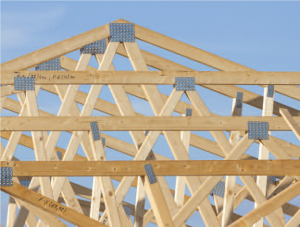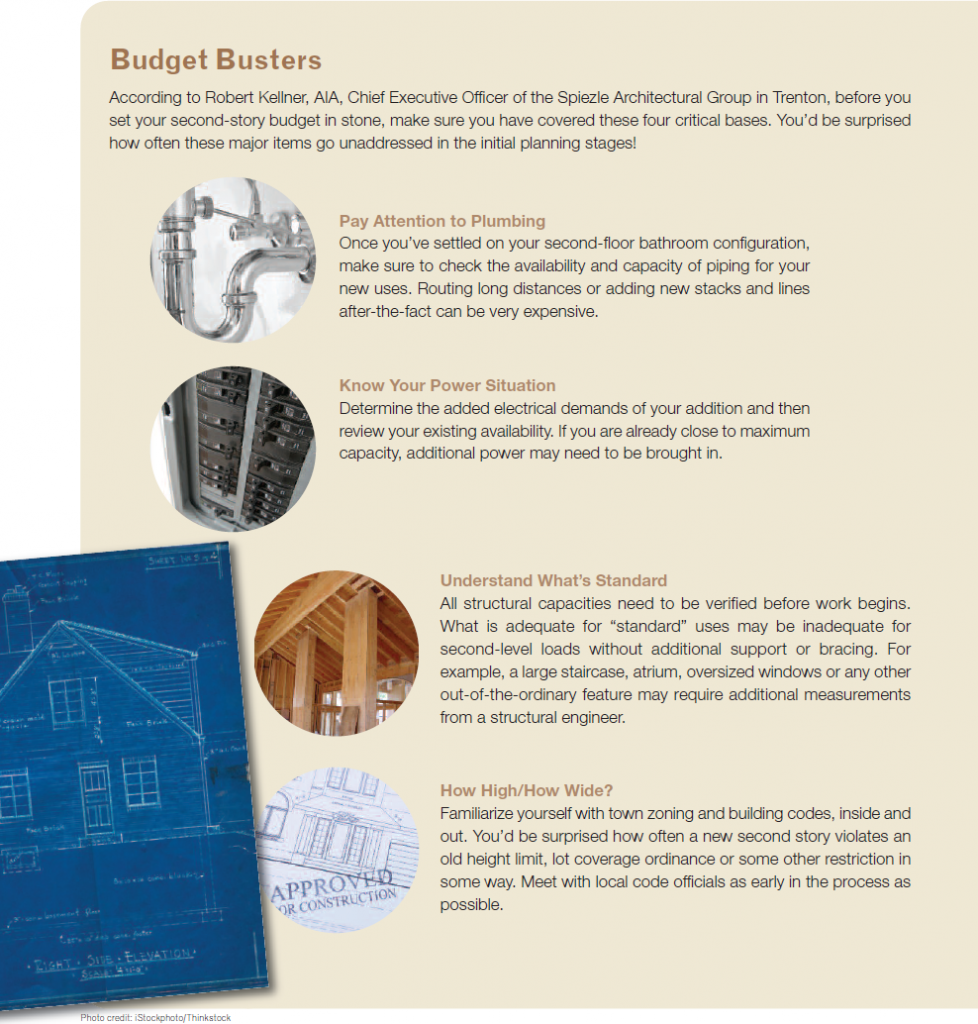The Big Build Up

Photo credit: iStockphoto/Thinkstock
Is there a second story in your future?
Moving up doesn’t have to mean moving out. More and more, owners of one-story dwellings in the Garden State have been addressing their space issues by adding a second floor. Yes, it’s expensive. And yes, it’s messy. But in many cases, “building up” makes more sense than shopping for a new home. There are any number of reasons to add a second story to your current home but, needless to say, they are all related to space. The big question is Why go through the time and trouble to do so if you could just buy something that suits your needs? Well, for starters, that would mean having to put your own (presumably undersized) house on the market for sale, or as a rental property. So there’s a major hassle factor. Also, you may be locked into a great mortgage rate in your current abode, or for some reason be unable to qualify for a favorable rate on a new property.
The most common answer to Why build up? is that you love your home, your neighborhood and your neighbors, and are willing to put up with the inconvenience in order to stay put. From an architect’s perspective, the primary challenges of designing a new home involve understanding a wide range of variables, and then reconciling them with the desires of the homeowner. The most cost-effective solution almost always involves using the existing foundation and exterior walls. A talented architect, working in concert with a structural engineer, should be able to check off most of the items on your list. For older homes—or homes that were constructed cheaply to begin with—there are going to be structural issues. However, rarely are they insurmountable. Hopefully, the solutions won’t bust your budget. Consulting with that structural engineer is a must. Understanding local building codes is obviously important, too. You’d be surprised to see what’s on the books in your town when it comes to staircases, ceiling heights, and room dimensions. The engineer sho uld also be able to tell you with absolute certainty whether you can get the job done without tearing out your first-floor ceilings. This greatly reduces the mess and expense. From a builder’s perspective, adding a second story isn’t all that different than building from the ground up.
uld also be able to tell you with absolute certainty whether you can get the job done without tearing out your first-floor ceilings. This greatly reduces the mess and expense. From a builder’s perspective, adding a second story isn’t all that different than building from the ground up.
In most cases, the addition fits neatly atop the current first floor, and uses the existing exterior walls as the primary support. In some cases, a modular addition can be employed, which offers significant savings. It’s partially assembled on the ground and then lifted into place with a new roof, or under your existing one. The interior finishing work is not all that different than any other home remodel job. From a realtor’s perspective, it usually makes sense to find something with more space in the same neighborhood. Especially in depressed markets, finding more space is cheaper than creating it. Of course, that generates a couple of potential commissions, but the facts do bear out this position. The addition of a second story rarely recoups the investment when it’s done. On average, in suburban areas, at least, the number seems to be around two-thirds. In other words, a $150,000 second-story addition may only increase your home’s value by $100,000. This is math you may be willing to live with, but it’s math you should do (with a competent and trusted realtor) before going all-in. Among the classic mistakes homeowners make is assuming their current attic construction will support a second floor. It almost certainly won’t.
Attics are not built to handle second-story traffic. There is no cost savings to be had here—it’s not as simple as simply raising the roof and converting gloomy storage space into a bright and airy second story. Also, that attic staircase you’d planned on repurposing is unlikely to pass muster with local building codes when it connects the two new living spaces. If you do not currently have a staircase in your home, keep in mind that it will have to go somewhere on your first floor—and that you may lose a room. Speaking of which, the plumbing, electric, heating and air conditioning systems that serve your first floor will need a lot more space on the first floor to make it up to the second floor. Some homeowners end up opting for an entirely new and separate set of systems for the addition. Keep in mind that part of the expense of adding a second story almost includes a new furnace, AC unit and water heater. Another consideration is what you’ll need to do to the exterior of your home to make it come together. That re-siding project you’ve putting off the last few years? Now’s the time to squeeze the trigger.
Y ou should also think about pulling together the interior. Indeed, a less common but still-critical mistake homeowners make is failing to really think through how the new second story will relate to the “new” first story in terms of how the entire home is used. Moving bedrooms to the second floor opens up all sorts of possibilities on the main level. If you determine how you might be using the first-floor space in the future, you can leave yourself a lot of options, especially if a new kitchen is part of the long-term plan. When it’s all said and done, a basic second-story addition will eat up a half-year of your life and cost you at least $125 to $150 per square foot, soup-to-nuts, plus professional fees. Depending on your desired finishes and a handful of other variables, the price tag of a 1,000-foot addition is likely to be in the neighborhood of $150,000. Does that make sense in your neighborhood? Ultimately, that’s a call you’ll have to make.
ou should also think about pulling together the interior. Indeed, a less common but still-critical mistake homeowners make is failing to really think through how the new second story will relate to the “new” first story in terms of how the entire home is used. Moving bedrooms to the second floor opens up all sorts of possibilities on the main level. If you determine how you might be using the first-floor space in the future, you can leave yourself a lot of options, especially if a new kitchen is part of the long-term plan. When it’s all said and done, a basic second-story addition will eat up a half-year of your life and cost you at least $125 to $150 per square foot, soup-to-nuts, plus professional fees. Depending on your desired finishes and a handful of other variables, the price tag of a 1,000-foot addition is likely to be in the neighborhood of $150,000. Does that make sense in your neighborhood? Ultimately, that’s a call you’ll have to make.





